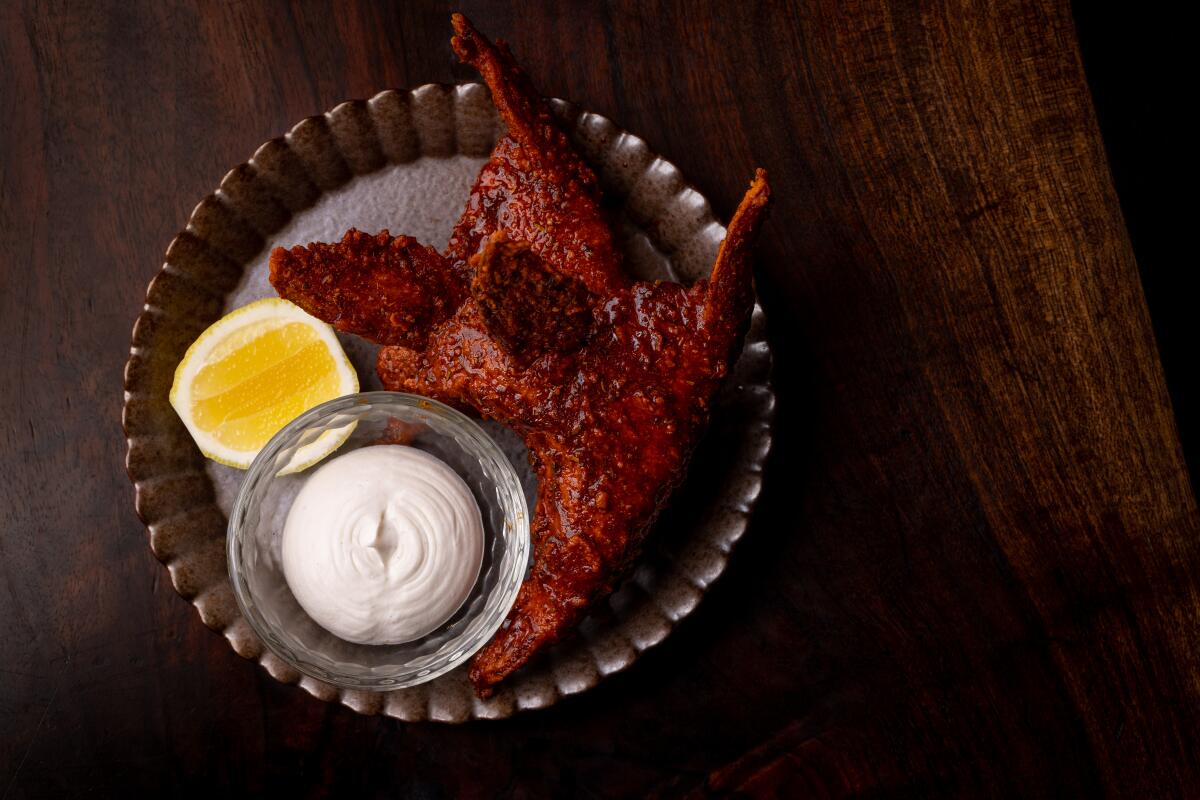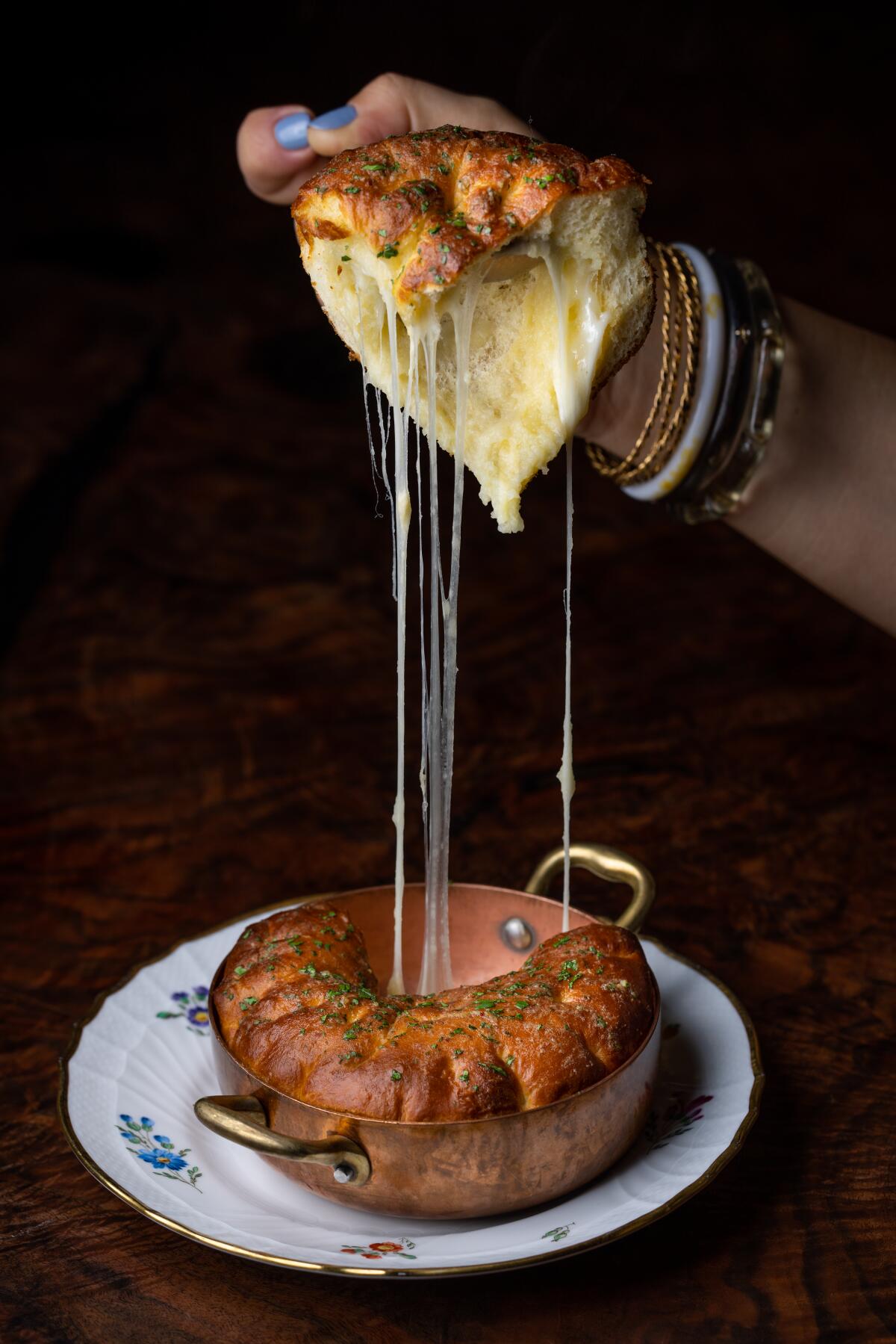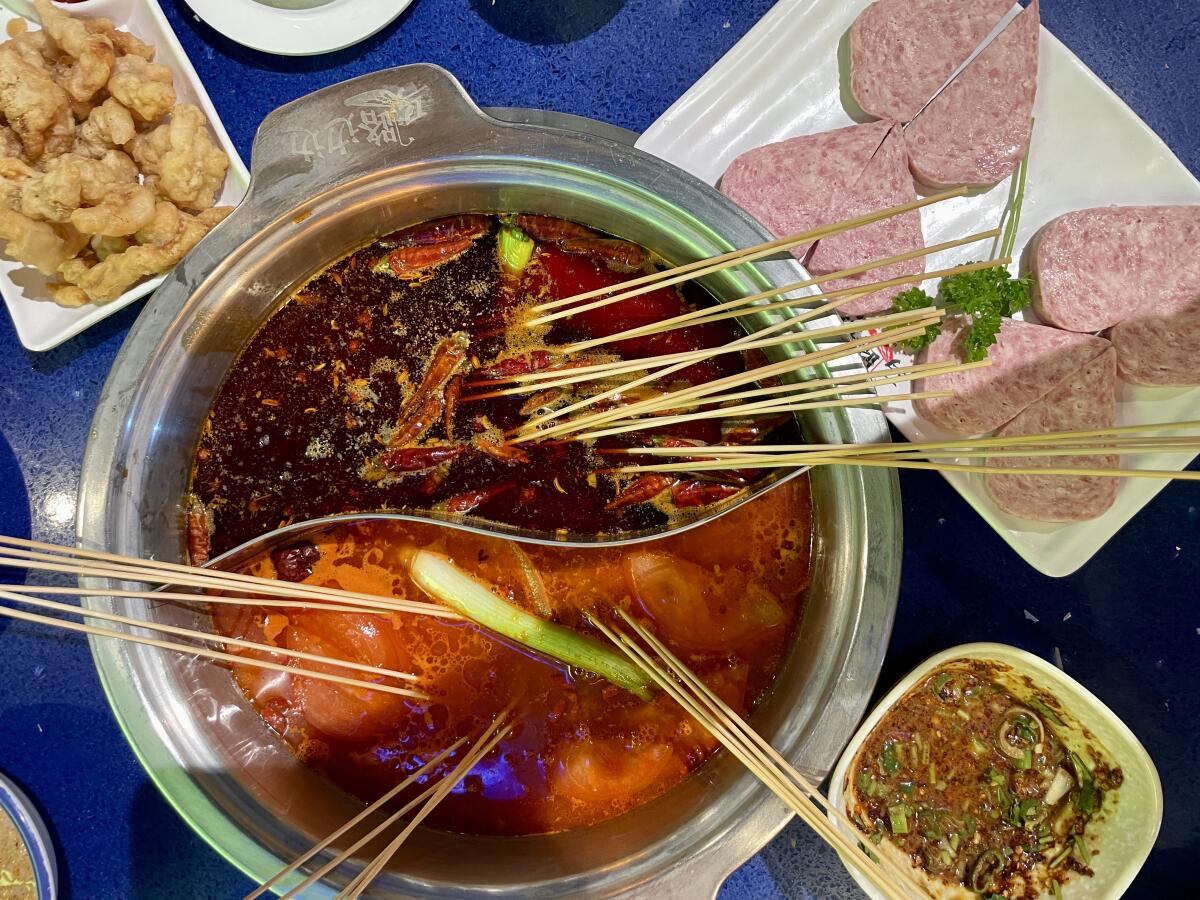Have you heard of hot fish? It’s the new hot chicken

The principles remain similar in chef Paul Chung’s treatment of striped bass from Baja. Plus, going for hot pot in Tustin.
- Share via
Over the last decade, I watched hot chicken take hold of Los Angeles in a way I’d never seen a dish grip an entire city. The fiery poultry with roots in Nashville is everywhere, with countless restaurants devoted to the stuff and hot chicken-inspired menu items across Southern California. With the Hotville food truck and two locations of Howlin’ Ray’s, it’s easy to understand the obsession. If hot chicken has become part of your weekly rotation, I’m about to make the argument for hot fish. Hear me out.
Kim Prince of Hotville and Johnny Ray Zone of Howlin’ Ray’s share hot chicken insights in the premiere of our ‘Bucket List’ fried chicken show.
Hot fried sea bass collars (and cheese bread) from Angler
Esther Tseng, a food writer and Times contributor, once called Angler Los Angeles at the Beverly Center a “steakhouse for seafood.” She was right. It’s a place where seafood is celebrated as the main attraction, showing up in dishes traditionally reserved for heavier proteins. Like a steakhouse, it wasn’t somewhere I thought to visit beyond a special occasion. The restaurant recently reopened with a new menu under the direction of Paul Chung, culinary director of Saison Hospitality. Now, it’s a place with cheesy bread, hot fried sea bass collars and a host of dishes you share and eat with your hands.
It’s a menu actuated by the time he spent growing up in Virginia, his love of Southern food and his Korean heritage. And Chung, like the rest of us, is a fan of Nashville hot chicken.
“I know here that Howlin’ Ray’s is really big,” he said. “I wanted to try a version with the hot fried collars.”
He sources his collars from a sustainable striped bass farm in Baja California. They’re fried like any good fried chicken, with a rough, crisp terrain. To make his hot oil for the fish (the ingredient that makes it a hot fried fish versus fried fish), he renders chicken fat in the smoker and combines it with clarified butter and oil. He also smokes dried guajillo, chile de Arbol, California and pasilla chiles and adds them to the oil with a handful of other spices. The collars are basted in the mixture, enveloping all available surfaces in the rust-colored oil.
If you’ve enjoyed a grilled fish collar at a sushi restaurant, you’ll understand why it’s the perfect ingredient for the hot chicken treatment. There’s enough gelatin in the fish to mimic a piece of chicken that’s both juicy and meaty. And the curve of the collars means more crispy edges. Chung’s hot oil is something that should be bottled. The smoke from the chicken fat and the chiles adds depth and vigor, lending an additional flavor profile beyond the heat.
Luckily, I was at dinner with a colleague who was also not shy about excavating for every last morsel of meat. Multiple napkins were soiled.

Then there’s the cheese bread, a dish that sells itself. The table to our left spied ours and ordered their own. We did the same after seeing an order on the table to our right.
Before you cut into it, it appears to be your average Parker House rolls, fused together, golden brown and shining with butter. It’s actually a creation inspired by the sweet potato and cheese pizzas Chung ate as a kid in Korea.
“It’s something that we just wanted to do that was fun,” Chung said. “They always piped sweet potato on the crust and I hated it as a kid,” he said. “In my older age when I went back and tried it again, it made sense.”
Chung’s cheese bread is filled with a molten center of cheese and potato puree and a top slick with anchovy butter. A few soft rind cheeses from Northern California lend a bit of funk, and there’s enough of some good melty cheeses (he didn’t specify the variety) so that when you break away a piece, the cheese stretch is impressively long.
Hot pot from Ma Lu Bian Bian

The dining room at the new Malu Bian Bian location in Tustin feels like the inside a comic book. Large animated murals of characters playing arcade games, driving, holding a giant spear or an astronaut on the moon cover the walls. The color scheme is bright royal blue, McDonald’s yellow and red. During peak and even beyond peak mealtimes, the tables are full and so is the condiment bar.
If you haven’t experienced hot pot before, let me introduce you to the condiment bar. This is where you concoct your own dipping sauce out of a collection of condiments, seasonings and chopped herbs. You can count on vinegar, soy sauce, sesame paste, at least a few iterations of chile (paste, powder, sauce), chopped green onion, chopped fresh garlic, chopped cilantro and sliced oranges that I like to use as a palate cleanser.
If you need some inspiration, there’s a mural above the bar with suggested ingredients and measurements for dipping sauces based on whatever you’re dipping. Choose your own adventure, but as long as you have enough chile and vinegar in the mix, you should be fine.
On a recent visit, I ordered both the traditional spicy soup base and the tomato soup base, served side by side in a sort of yin-yang metal vat. The traditional spicy can appear menacing once your server turns on the burner below, the roiling liquid anathema to anything swimming in its chile-studded, crimson depths. It’s hot. Hot in a way that will make you perspire both from the spice and the heat. And hot in a way that builds as dinner progresses, leaving your eyes watering and sweat dripping onto your bib. Yes, there are bibs.
Though large gatherings are not allowed due to COVID-19 guidelines, the traditional Asian meal of hot pot still provides comfort to many, just in smaller groups.
The traditional spicy broth imparts heat and a little garlic to everything it touches, making it the ideal cooking base for the New Zealand lamb, shrimp, cabbage, mushrooms, lemon beef (raw beef wrapped around slices of lemon) and house-made “Spam meat.” On the opposite side, the tomato base is mild with a subtle tomato flavor. I found it was the best way to appreciate the house-made meatball combo, served as 12 spoons, each filled with either beef, chicken or fish meatballs.
My go-to hot pot strategy is to cram as many skewers, stray vegetables and shavings of meat into the broth in one go as possible. I’m impatient and hungry. When you go, the pace is up to you. You’re the architect of your own hot pot destiny.
Where to eat now
Angler, 8500 Beverly Blvd. Suite 117, Los Angeles, (424) 332-4082, anglerla.com
Ma Lu Bian Bian, 1056 Walnut Ave., Tustin, (657) 600-8116, malubianbianca.com
More to Read
Eat your way across L.A.
Get our weekly Tasting Notes newsletter for reviews, news and more.
You may occasionally receive promotional content from the Los Angeles Times.













